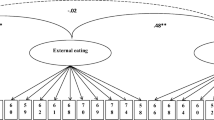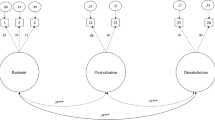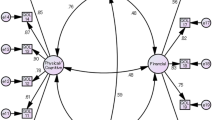Abstract
Objective
The main purpose of the present study was to assess the factor structure, the convergent and divergent validity, and the reliability of the Eating Attitude Test (EAT-26) in a sample of female Iranian students.
Method
After a rigorous translation and back-translation of the EAT-26, 561 female students from the Tonekabon branch of the Islamic Azad University completed the EAT-26, the Binge Eating Scale (BES), the Beck Depression Inventory-II (BDI-II) and the Beck Anxiety Inventory (BAI). Six weeks later, 74 of these students participated in a test–retest procedure.
Results
The exploratory factor analysis resulted in a five-factor solution that accounted for 50 % of the total variance. The factors included “drive for thinness”, “restrained eating”, “perceived social pressure to eat”, “oral control”, and “bulimia”. These factors demonstrated satisfactory concurrent validity, acceptable to high internal consistency (0.76–0.92), and low test–retest reliability (0.26–0.64). The factors effectively identified the students who were currently on a diet, and those who had never participated in a weight reduction program.
Conclusion
The results provide mixed support for the reliability and validity of the EAT-26 for a non-clinical Iranian population. However, its discriminant validity makes it a useful measure for screening purposes and identifying women at risk for developing disordered eating or eating disorders. Future research should replicate this study in both non-clinical and clinical settings in Iran.
Similar content being viewed by others
References
Chisuwa N, O’Dea JA (2010) Body image and eating disorders amongst Japanese adolescents. A review of the literature. Appetite 54:5–15
Ho TF, Tai BC, Lee EL, Cheng S, Liow PH (2006) Prevalence and profile of females at risk of eating disorders in Singapore. Singapore Med J 47(6):499–503
Mumford DB, Whitehouse AM, Choudry IY (1992) Survey of eating disorders in English-medium schools in Lahore, Pakistan. Int J Eat Disord 11:173–184
Sjostedt JP, Schumaker JF, Nathawat SS (1998) Eating disorders among Indian and Australian university students. J Soc Psychol 3:351–357
Nobakht M, Dezhkam M (2000) An epidemiological study of eating disorders in Iran pp. 265–271
Garner DM, Garfinkel PE (1979) The Eating Attitudes Test: an index of the symptoms of anorexia nervosa. Psychol Med 9:273–279
Garfinkel PE, Newman A (2001) The Eating Attitudes Test: twenty-five years later. Eat Weight Disord 6:1–25
Garner DM, Olmsted MP, Bohr Y, Garfinkel PE (1982) The Eating Attitudes Test: psychometric features and clinical correlates. Psychol Med 12:871–878
Pereira AT, Maia B, Bos S, Soares MJ, Marques M, Macedo A, Azevedo MH (2008) The Portuguese short form of the Eating Attitudes Test-40. Eur Eat Disord Rev 16(4):319–325
Douka A, Grammatopoulou E, Skordilis E, Koutsouki D (2009) Factor analysis and cut-off score of the 26-item eating attitudes test in a greek sample. JBE 5(1):51–68
Mumford DB (2006) A pilot study of eating disorders in Mirpur (Pakistan) using an Urdu version of the Eating Attitudes Test. Int J Eat Disord 11:243–251
Szabo C, Allwood CW (2004) Application of the Eating Attitudes Test (EAT-26) in a rural, Zulu speaking, adolescent population in South Africa. World Psychiatry 3(3):169–172
Nasser M (1994) The psychometric properties of the Eating Attitude Test in a non-Western population. Soc Psychiatry Psychiatr Epidemiol 29:88–94
Rayón A, Mancilla-Díaz JM, Vázquez-Arévalo R, Unikel-Santoncini C, Caballero-Romo A, Mercado-Corona D (2004) Validity of the Eating Attitudes Test: a study of Mexican eating disorders patients. Eat Weight Disord 9:243–248
Doninger GL, Enders CK, Burnett KF (2005) Validity Evidence for Eating Attitudes Test Scores in a sample of female college athletes. Meas Phys Educ Exerc Sci 9:35–49
Lane HJ, Lane AM, Matheson H (2004) Validity of The Eating Attitude Test Among Exercisers. J Sports Sci Med 3:244–253
Ocker L, Lam ETC, Jensen BE, Zhang JJ (2007) Psychometric Properties of the Eating Attitudes Test. Meas Phys Educ Exerc Sci 11:25–48
Rivas T, Bersabé R, Jiménez M, Berrocal C (2010) The Eating Attitudes Test (EAT-26): reliability and validity in Spanish female samples. Span J Psychol 13(2):1044–1056
Canals J, Carbajo G, Fernández-Ballart J (2002) Discriminant validity of the Eating Attitudes Test according to American Psychiatric Association and World Health Organization criteria of eating disorders. Psychol Rep 91:1052–1056
AI-Subaie A, Al-Shammari A, Bamgboye E, Al-Sabhan K, Al-Shehri S, Bannah AR (1996) Validity of the Arabic version of the Eating Attitude Test. Int J Eat Disord 20(3):321–324
Babaee S, Khodapanah MK, Sedghpour BS (2008) Validity and reliability of Eating Attitude Test. JBS 1:61–68
Myeres LS, Gamst G, Guarino AJ (2007) Applied multivariate research: design and interpretation. SAGE, London
Gormally J, Black S, Daston S, Rardin D (1982) The assessment of binge eating severity among obese persons. Addict Behav 7:47–55
Dezhkam M, Moloodi R, Mootabi F, Omidvar N (2009) Standardization of binge eating scale among Iranian obese population. Iran J Psychiatry 4:143–147
Beck AT, Steer RA, Brown GK (1996) Manual for the BDI-II. The Psychological Corporation, San Antonio
Cohen A (2008) The underlying structure of the Beck Depression Inventory II: a multidimensional scaling approach. J Res Pers 42:779–786
Steer RA, Rissmiller DJ, Beck AT (2000) Use of the Beck Depression Inventory-II with depressed geriatric inpatients. Behav Res Ther 38:311–318
Fata L (2001) Meaning structures/schema, emotional states and emotional information processing: comparison of two conceptual framework. Iran University of Medical Sciences, Tehran
Beck AT, Epstein N, Brown G, Steer RA (1988) An inventory for measuring clinical anxiety: psychometric properties. J Consult Clin Psych 56:893–897
Terry PC, Lane AM, Warren L (1999) Eating attitudes, body shape perceptions, and mood among elite rowers: effects of age, gender and weight category. J Sports Sci Med 2:27–77
Pearlstein T (2002) Eating disorders and comorbidity. Arch Womens Ment Health 4:67–78
Fairburn CG (2008) Eating Disorders: the transdiagnostic view and the cognitive behavioral theory. In: Fairburn CG (ed) Cognitive behavior therapy and eating disorders. Guilford Press, New York, pp 7–22
Conflict of interest
On behalf of all authors, the corresponding author states that there is no conflict of interest.
Author information
Authors and Affiliations
Corresponding author
Rights and permissions
About this article
Cite this article
Ahmadi, S., Moloodi, R., Zarbaksh, MR. et al. Psychometric properties of the Eating Attitude Test-26 for female Iranian students. Eat Weight Disord 19, 183–189 (2014). https://doi.org/10.1007/s40519-014-0106-7
Received:
Accepted:
Published:
Issue Date:
DOI: https://doi.org/10.1007/s40519-014-0106-7




